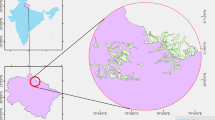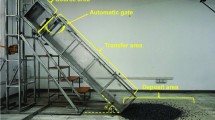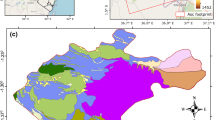Abstract
With the aggravation of climate warming, unstable soil slopes are more and more common in permafrost regions. The long-term monitoring of a slow earthflow (K178 + 530 landslide) in the Xiao Xing’an Mountains permafrost area in Northeast China was carried out. The deformation characteristics and occurrence mechanism of the landslide were studied using field investigation, on-site drilling, sensor monitoring, laboratory test, Google satellite image, unmanned aerial vehicle photogrammetry, and high-density resistivity. To analyze the variation laws of pore water pressure and effective stress and their influence on slope deformation, a coupled hydro-thermo-mechanical model was established to reconstruct the deformation process of the slope. The results show that the groundwater recharge from the permafrost degradation and surface infiltration reduces the soil cohesion and internal friction angle near the main scarp and increases the soil gravity, thus providing dynamic and mechanical conditions for slope deformation. The melting of the continuous segregation ice in the active layer and surface infiltration reduces the soil strength of the sliding surface and provides deformation conditions for the start of the landslide. The combination of these two factors finally led to the occurrence of the landslide. According to its deformation mechanism, it can be judged that the landslide is a thrust-type landslide. In addition, after the melting of the segregation ice, the upper soil slides along the slope under the action of gravity, causing the sliding surface to be parallel to the slope surface. The soil near the main scarp slides downward and accumulates near the toe to form several transverse ridges. The instability of the transverse ridges produces secondary sliding which causes the toe to advance continuously. The numerical simulation results can intuitively reflect the stage deformation characteristics of the slope, pore water pressure changes, and effective stress distributions, which provides a supplement for further understanding the formation mechanism and deformation process of the landslide.














Similar content being viewed by others
Data availability
All the data used in this study are available from the corresponding author upon request.
References
Biskaborn BK, Smith SL, Noetzli J et al (2019) Permafrost is warming at a global scale. Nat Commun 10:264. https://doi.org/10.1038/s41467-018-08240-4
Cardarelli E, Marrone C, Orlando L (2003) Evaluation of tunnel stability using integrated geophysical methods. J Appl Geophys 52(2–3):93–102. https://doi.org/10.1016/S0926-9851(02)00242-2
Chang W, Xu Q, Dong X et al (2022) Dynamic process analysis of the Xinmo landslide via seismic signal and numerical simulation. Landslides 19:1463–1478. https://doi.org/10.1007/s10346-022-01876-w
Cheng G, Wu T (2007) Responses of permafrost to climate change and their environmental significance, Qinghai-Tibet Plateau. J Geophys Res Earth Surf. https://doi.org/10.1029/2006JF000631
Donohue S, Gavin K, Tolooiyan A (2011) Geophysical and geotechnical assessment of a railway embankment failure. Near Surf Geophys 9(1):33–44. https://doi.org/10.3997/1873-0604.2010040
Fan X, Juang CH, Wasowski J et al (2018) What we have learned from the 2008 Wenchuan Earthquake and its aftermath: a decade of research and challenges. Eng Geol 241:25–32. https://doi.org/10.1016/j.enggeo.2018.05.004
Fan X, Tang J, Tian S, Jiang Y (2020) Rainfall-induced rapid and long-runout catastrophic landslide on July 23, 2019 in Shuicheng, Guizhou, China. Landslides 17:2161–2171. https://doi.org/10.1007/s10346-020-01454-y
Gao Q, Wen Z, Wang D et al (2018) Study on the instability process of slopes in permafrost regions by direct shear test of freezing-thawing interface. Rock Soil Mech 39(8):2814–2822
Gorr AN, McGuire LA, Youberg AM, Rengers FK (2022) A progressive flow-routing model for rapid assessment of debris-flow inundation. Landslides. https://doi.org/10.1007/s10346-022-01890-y
Gruber S (2012) Derivation and analysis of a high-resolution estimate of global permafrost zonation. Cryosphere 6:221–233. https://doi.org/10.5194/tc-6-221-2012
Guo Y, Shan W, Zhang C et al (2021) Monitoring of permafrost degradation along the Bei’an-Heihe Expressway in China. Bull Eng Geol Environ 80:1–10. https://doi.org/10.1007/s10064-020-01919-3
Harris C, Arenson LU, Christiansen HH et al (2009) Permafrost and climate in Europe: monitoring and modelling thermal, geomorphological and geotechnical responses. Earth Sci Rev 92:117–171. https://doi.org/10.1016/j.earscirev.2008.12.002
Hu Z, Shan W (2016) Landslide investigations in the northwest section of the lesser Khingan range in China using combined HDR and GPR methods. Bull Eng Geol Environ 75:591–603. https://doi.org/10.1007/s10064-015-0805-y
Huang X, Guo F, Deng M et al (2020) Understanding the deformation mechanism and threshold reservoir level of the floating weight-reducing landslide in the Three Gorges Reservoir Area, China. Landslides 17:2879–2894. https://doi.org/10.1007/s10346-020-01435-1
Jha MK, Peiffer S (2006) Applications of remote sensing and GIS technologies in groundwater hydrology: past, present and future. BayCEER, Bayreuth
Jin H, Li S, Cheng G et al (2000) Permafrost and climatic change in China. Glob Planet Change 26:387–404. https://doi.org/10.1016/S0921-8181(00)00051-5
Jin H, Zhao L, Wang S, Guo D (2006) Evolution of permafrost and environmental changes of cold regions in eastern and interior Qinghai-Tibetan plateau since the holocene. Quat Sci 26:198–210
Jin H, Huang Y, Bense VF et al (2022) Permafrost degradation and its hydrogeological impacts. Water 14:372. https://doi.org/10.3390/w14030372
Kääb A (2008) Remote sensing of permafrost-related problems and hazards. Permafr Periglac Process 19:107–136. https://doi.org/10.1002/ppp.619
Kawamura S, Miura S (2013) Rainfall-induced failures of volcanic slopes subjected to freezing and thawing. Soils Found 53:443–461. https://doi.org/10.1016/j.sandf.2013.04.006
Lai Y, Li S, Qi J et al (2008) Strength distributions of warm frozen clay and its stochastic damage constitutive model. Cold Reg Sci Technol 53:200–215. https://doi.org/10.1016/j.coldregions.2007.11.001
Lai YM, Zhang MY, Li SY (2009) Theory and application of cold regions engineering. Science Press, Beijing
Lee S, An H, Kim M et al (2022) Evaluation of different erosion–entrainment models in debris-flow simulation. Landslides. https://doi.org/10.1007/s10346-022-01901-y
Leibman M, Khomutov A, Kizyakov A (2014) Cryogenic landslides in the West-Siberian plain of Russia: classification, mechanisms, and landforms. Environmental science and engineering. Springer, pp 143–162
Li S, Lai Y, Zhang S, Liu D (2009) An improved statistical damage constitutive model for warm frozen clay based on Mohr-Coulomb criterion. Cold Reg Sci Technol 57:154–159. https://doi.org/10.1016/j.coldregions.2009.02.010
Li Y, Jin H, Wen Z et al (2022) Stability of permafrost slopes:a review. J Glaciol Geocryol 44(1):203–216
Liu Z, Yu X (2011) Coupled thermo-hydro-mechanical model for porous materials under frost action: theory and implementation. Acta Geotech 6:51–65. https://doi.org/10.1007/s11440-011-0135-6
López-Vinielles J, Ezquerro P, Fernández-Merodo JA et al (2020) Remote analysis of an open-pit slope failure: Las Cruces case study, Spain. Landslides 17:2173–2188. https://doi.org/10.1007/s10346-020-01413-7
Niu F, Luo J, Lin Z et al (2016) Thaw-induced slope failures and stability analyses in permafrost regions of the Qinghai-Tibet Plateau, China. Landslides 13:55–65. https://doi.org/10.1007/s10346-014-0545-2
Obu J (2021) How much of the earth’s surface is underlain by permafrost? J Geophys Res Earth Surf. https://doi.org/10.1029/2021JF006123
Obu J, Westermann S, Bartsch A et al (2019) Northern Hemisphere permafrost map based on TTOP modelling for 2000–2016 at 1 km2 scale. Earth Sci Rev 193:299–316. https://doi.org/10.1016/j.earscirev.2019.04.023
Runqiu H (2009) Some catastrophic landslides since the twentieth century in the southwest of China. Landslides 6:69–81. https://doi.org/10.1007/s10346-009-0142-y
Sauvin G, Lecomte I, Bazin S, Hansen L, Vanneste M, L’Heureux JS (2014) On the integrated use of geophysics for quick-clay mapping: the Hvittingfoss case study, Norway. J Appl Geophys 106:1–13. https://doi.org/10.1016/j.jappgeo.2014.04.001
Shan W, Hu Z, Guo Y, Zhang C, Wang C, Jiang H, Liu Y, Xiao J (2015) The impact of climate change on landslides in southeastern of high-latitude permafrost regions of china. Front Earth Sci 3(7):1–11
Shan W, Xu Z, Guo Y et al (2020) Geological methane emissions and wildfire risk in the degraded permafrost area of the Xiao Xing’an Mountains, China. Sci Rep 10:21297. https://doi.org/10.1038/s41598-020-78170-z
Shan W, Ma M, Guo Y, Zhang C (2022a) Numerical analysis of the influence of block-stone embankment filling height on the water, temperature, and deformation distributions of subgrade in permafrost regions. Water 14:1382. https://doi.org/10.3390/w14091382
Shan Y, Chen S, Zhong Q et al (2022b) Development of an empirical model for predicting peak breach flow of landslide dams considering material composition. Landslides 19:1491–1518. https://doi.org/10.1007/s10346-022-01863-1
Siva Subramanian S, Ishikawa T, Tokoro T (2017) Stability assessment approach for soil slopes in seasonal cold regions. Eng Geol 221:154–169. https://doi.org/10.1016/j.enggeo.2017.03.008
Siva Subramanian S, Fan X, Yunus AP et al (2020) A sequentially coupled catchment-scale numerical model for snowmelt-induced soil slope instabilities. J Geophys Res Earth Surf. https://doi.org/10.1029/2019JF005468
Sun H, Niu F, Zhang K, Ge X (2017) Seismic behaviors of soil slope in permafrost regions using a large-scale shaking table. Landslides 14:1513–1520. https://doi.org/10.1007/s10346-017-0823-x
Sun Z, Ma W, Zhang S et al (2018) Characteristics of thawed interlayer and its effect on embankment settlement along the Qinghai-Tibet Railway in permafrost regions. J Mt Sci 15:1090–1100. https://doi.org/10.1007/s11629-017-4643-1
Tyszkowski S, Kaczmarek H, Słowiński M et al (2015) Geology, permafrost, and lake level changes as factors initiating landslides on Olkhon Island (Lake Baikal, Siberia). Landslides 12:573–583. https://doi.org/10.1007/s10346-014-0488-7
Valarezo D, Mendieta G, Quiñones-Cuenca M et al (2020) Landslide monitoring system through wireless sensor network using RTK Technique: case of study basin of Loja City. In: Fosenca CE, Rodríguez Morales G, Orellana Cordero M, Botto-Tobar M, Crespo Martínez E, Patiño León A (eds) Information and communication technologies of Ecuador (TIC.EC). TICEC 2019. Advances in intelligent systems and computing, vol 1099. Springer, Cham
Wang B, Paudel B, Li H (2009) Retrogression characteristics of landslides in fine-grained permafrost soils, Mackenzie Valley, Canada. Landslides 6:121–127. https://doi.org/10.1007/s10346-009-0150-y
Wang G, Zhang D, Furuya G, Yang J (2014) Pore-pressure generation and fluidization in a loess landslide triggered by the 1920 Haiyuan earthquake, China: a case study. Eng Geol 174:36–45. https://doi.org/10.1016/j.enggeo.2014.03.006
Wang H, Yang R, Zhao L et al (2022) The application effect of remote sensing technology in hydrogeological investigation under big data environment. J Sens
Wei W, Hui L (2016) Progress in application of remote sensing data in hydrological simulation. Remote Sens Technol Appl 30(6):1042–1050
Wei M, Fujun N, Satoshi A, Dewu J (2006) Slope instability phenomena in permafrost regions of Qinghai-Tibet Plateau, China. Landslides 3:260–264. https://doi.org/10.1007/s10346-006-0045-0
Wei S, Tao Y, Ying G et al (2022) Thermohydromechanical coupling analysis and engineering verification of gravel pile groups for strengthening permafrost marshland highway foundations. Bull Eng Geol Environ 81:294. https://doi.org/10.1007/s10064-022-02796-8
Wirz V, Geertsema M, Gruber S, Purves RS (2016) Temporal variability of diverse mountain permafrost slope movements derived from multi-year daily GPS data, Mattertal, Switzerland. Landslides 13:67–83. https://doi.org/10.1007/s10346-014-0544-3
Wu Q, Zhang T (2008) Recent permafrost warming on the Qinghai-Tibetan Plateau. J Geophys Res Atmos. https://doi.org/10.1029/2007JD009539
Xian Y, Wei X, Zhou H et al (2022) Snowmelt-triggered reactivation of a loess landslide in Yili, Xinjiang, China: mode and mechanism. Landslides. https://doi.org/10.1007/s10346-022-01879-7
Xu H, Liu H (2019) Multi-scale rainfall characteristics of rainfall-induced landslides. Mt Res 37:858–867
Yamakawa Y, Kosugi K, Masaoka N, Tada Y, Mizuyama T (2010) Use of a combined penetrometer-moisture probe together with geophysical methods to survey hydrological properties of a natural slope. Vadose Zone J 9(3):768–779. https://doi.org/10.2136/vzj2010.0012
Yan J, Chen J, Zhou F et al (2022) Numerical simulation of the Rongcharong paleolandslide river-blocking event: implication for the longevity of the landslide dam. Landslides 19:1339–1356. https://doi.org/10.1007/s10346-022-01872-0
Yao W, Li C, Yan C, Zhan H (2022) Slope reliability analysis through Bayesian sequential updating integrating limited data from multiple estimation methods. Landslides 19:1101–1117. https://doi.org/10.1007/s10346-021-01812-4
Zhang CC, Shan W, Liu S, Guo Y, Qiu L (2023) Simulation of spatiotemporal distribution and variation of 30 m resolution permafrost in northeast China from 2003 to 2021. Sustainability 15(19):14610. https://doi.org/10.3390/su151914610
Zhang H, Zhang J, Zhang Z et al (2016) A consolidation model for estimating the settlement of warm permafrost. Comput Geotech 76:43–50. https://doi.org/10.1016/j.compgeo.2016.02.013
Zhang M, Zhou B, Cheng Q et al (2021) Investigation of the triggering mechanism and runout characteristics of an earthflow in Zhimei village, Chengduo, Qinghai, China. Nat Hazards 109:903–929. https://doi.org/10.1007/s11069-021-04861-z
Zhou Z, Ma W, Zhang S et al (2016) Multiaxial creep of frozen loess. Mech Mater 95:172–191. https://doi.org/10.1016/j.mechmat.2015.11.020
Zhou X, Jia Q, Shi P et al (2022) Application of image-free control uav aerial survey technology in emergency treatment of landslide-debris flow disaster in Lijie north hill, Zhouqu county. Chin J Geol Hazard Control 33(1):107–116. https://doi.org/10.16031/j.cnki.issn.1003-8035.2022.01-13
Acknowledgements
We thank the Field scientific observation and research station of the Ministry of Education-Geological environment system of permafrost area in Northeast China (MEORS-PGSNEC) for its help.
Funding
This work was supported by the National Natural Science Foundation of China (Grant No. 41641024) and the Science and Technology Project of Heilongjiang Communications Investment Group (Grant No. JT-100000-ZC-FW-2021-0182).
Author information
Authors and Affiliations
Contributions
Conceptualization: WS; Writing-original draft preparation: MM, WS; Writing-review and editing: WS, MM, CZ and YG; Visualization: MM and WS; Supervision: WS; Project administration: WS; Funding acquisition: WS; All authors have read and agreed to the published version of the manuscript.
Corresponding author
Ethics declarations
Conflict of interest
The authors declare no competing interests.
Additional information
Publisher's Note
Springer Nature remains neutral with regard to jurisdictional claims in published maps and institutional affiliations.
Rights and permissions
Springer Nature or its licensor (e.g. a society or other partner) holds exclusive rights to this article under a publishing agreement with the author(s) or other rightsholder(s); author self-archiving of the accepted manuscript version of this article is solely governed by the terms of such publishing agreement and applicable law.
About this article
Cite this article
Zhang, C., Ma, M., Shan, W. et al. Process and numerical simulation of landslide sliding caused by permafrost degradation and seasonal precipitation. Nat Hazards 120, 5429–5458 (2024). https://doi.org/10.1007/s11069-024-06433-3
Received:
Accepted:
Published:
Issue Date:
DOI: https://doi.org/10.1007/s11069-024-06433-3




